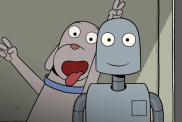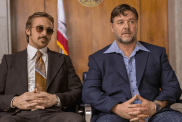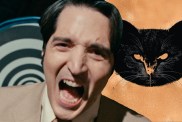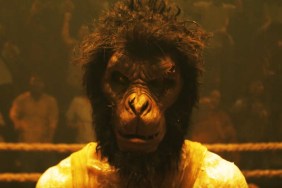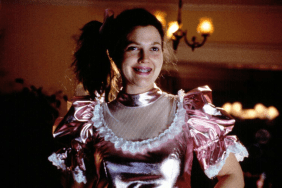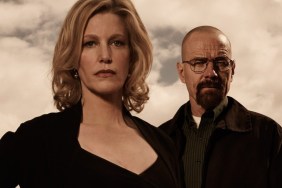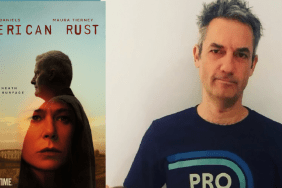Two years ago, director Joe Wright garnered a bit of attention for his 2005 adaptation of Jane Austen’s Pride & Prejudice, but that now seems fairly miniscule to the scrutiny that’s been put on his every move since it was announced that he would direct Christopher (Dangerous Liaisons) Hampton’s adaptation of Ian McEwan’s Atonement, a gripping hard-to-label story about a mistake in judgment made by a young girl named Briony Talis that stays with her for her entire life. It stars James McAvoy and Keira Knightley as young lovers who are split apart by Briony’s decision while they’re all very young, sending McAvoy’s character Robbie to the French front during WWII, though it takes a different approach to the normal war-time romantic drama we’ve seen before.
Atonement is a far more challenging film in terms of scope, tone and pacing than Pride & Prejudice, but Wright has proven that his first film was no fluke as he’s imposed a visionary direction to McEwan’s novel to create a riveting film notable for the three performances that make up the three stages in Briony Talis’ life, played by newcomer Saoirse Ronan, Romola Garai and acting legend Vanessa Redgrave.
ComingSoon.net had two chances to speak with Wright, both times outside the U.S., the first time we sat down with him for ten minutes at the Toronto Film Festival, where the film had its North American premiere, and then once again in London at the film’s official junket. Both times we didn’t have nearly as much time as necessary to really get into the head of this exciting filmmaker, but we did the best we could.
ComingSoon.net: So you’re back working with most of the same team, back with Keira, but making a completely different movie.
Joe Wright: I really like the thing of having a company of actors and I like the company atmosphere, so it’s important for me to work with the same people. It makes me feel safe, and we kind of understand each other.
CS: I assume you had a bigger budget this time around.
Wright: Not really. Well, about $4 million more.
CS: That’s still a lot, but it looks like $50 million more.
Wright: Right, no, no, no, it’s a budget of $30 million.
CS: That’s pretty amazing, especially when you consider things like the tracking shot on the beach
Wright: Yeah, I mean a lot of the budget went on that, but it was only one day we had to shoot it, and that’s in a way why I did that tracking shot, is ’cause I had one day to film that whole scene and thought that maybe the best way to do that was to concentrate on the rehearsals all day and then use the last 3 hours of the day to shoot. It was partly financial constraints that led to us shooting it in that way.
CS: How long did it take to set everything up though?
Wright: 12 hours… well, the art department had been there for six weeks beforehand, so they’d been getting it all set for six weeks and it was a fairly big job.
CS: It looked it. I remember talking to Alfonso Cuaron, who told me that it took them ten days just to set everything up for that big finale in “Children of Men” and then one whole day of filming once they had it worked out.
Wright: We didn’t have that luxury.
CS: Can you talk about how that idea came about?
Wright: It started off as a bit of a joke really. I had a problem which was that I only had one day with all of those extras, and we couldn’t afford any more, and the sequence was originally written as a montage and I wasn’t sure how I was going to cover that amount of shots in a single day and have continuity of light and “magic light” and all that kind of stuff, so one day in discussion with Seamus (the cinematographer), I sort of jokingly said, “Why don’t we do it as a single Steadicam shot” and everyone laughed. “Ha ha ha, what a wag!” and then I went home that night and started thinking about it, and asking myself the question quite seriously. I reread the passage from the book and it’s a really lyrical passage, so it seemed like the right way to do it, so the next day I went in and told them and they stopped laughing. It was something that we prepared very closely for but the heroes of that day were the extras who really gave their heart and soul to the dignity of the moment and also the camera team and the Steadicam operator who just did an extraordinary job. But it was an amazing thing to have 1,300 people focus on one five-minute section.

CS: Was this movie something you already had in the works as you were finishing up “Pride & Prejudice”?
Wright: I was finishing “Pride & Prejudice” and “Pride” was the first story I ever told with a happy ending. I was kind of fascinated with happy endings and what they were for, what their purpose was, so while I was finishing “Pride,” Tim Bevin came to me and said, “We’ve got this project ‘Atonement.’ Have you read the novel?” And I hadn’t, so I read it quite quickly and immediately said, “This is what I want to do next.” It spoke to a lot of the issues I’d been thinking about in terms of storytelling and happy endings. There was a script that Christopher Hampton had written with the previous director, Richard Eyre, and I read that script and didn’t feel that it was in line with the film I wanted to make, and felt like I needed to get some ownership of the material, in a way, creatively. So we started again, and what I was interested in doing was a very faithful adaptation to the book. We literally kept the book on one side and the script on the other and we slowly worked through it, and that’s how we came up with it.
CS: I haven’t read the book yet, but is the structure similar with the non-linear telling of stories from different viewpoints, such as the fountain scene?
Wright: The structure is practically exactly the same. That’s some of the stuff that I was most fascinated by, and I can imagine that was the stuff that had been pulled into the more linear structure by the previous director.
CS: I think it’s a movie that you have to see more than once to really appreciate.
Wright: I hope so.
CS: One of the things I really liked was how some of the visual parallels you drew between Briony falling into the water and the fountain scene. Was a lot of that referred to in the book with literary parallels?
Wright: Some of them. Some of them not. The water motif of Cecelia wasn’t in the book and that was something I kind of developed intuitively really. I didn’t intellectually think “Oh, I want to do a water motif with Cecelia,” it just kind of developed. It’s a funny thing when you’re designing a film. You have certain images in place and then it starts to, almost like painting, you’re balancing the composition if you like.
CS: When people heard that Keira was making another movie with you, we automatically assume she’s going to be the lead, but it’s really more about Robbie and Briony even.
Wright: I think certainly that Briony is the lead character, although actually, it’s played by three different actors, but Robbie/James has the most screen time, and so maybe he’s the front filling.
CS: The casting of the three actresses as Briony is something that leaves a lasting impression, because it’s more than just the hair style that makes them seem like the same character. Each of them show the same characteristics as the character. Did you film one of them first and then have the other two watch and modify their performance to that?
Wright: Yeah, I did. Most importantly, I cast Saoirse Roman first, before the adults, and normallyI think I’m right in saying thiswhen you’re casting a character who’s seen also as a child and an adult, you cast the adult first and then try to find a child that looks like the adult and also can act. I knew that would be a tall order, because they’re not that many kids that can act. So I cast Saoirse first, and then based my cast on her, although I always kind of had Vanessa in mind. I always hoped that Vanessa would work, and then we did rehearsals with the three of them where they all played silly games of copying each other’s movements and walking the same way. All three of them together, and it was really interesting studying the ideas of development of personality and expression. It was a very strange three days with those three, and then I did shoot all of Saoirse’s stuff first and then exactly as you suggest, I showed both Romola and Vanessa what Briony
and I only showed them Briony’s point of view of any scene, so they never saw the fountain scene from Robbie and Cecelia’s point of view and they never saw the library scene from their point of view. They only saw stuff that Briony would have seen.
CS: Vanessa is one of those actresses who you could put in a movie and do a monologue and suddenly, even a great movie is elevated that much more.
Wright: Absolutely, I totally agree. You could have her read the phone book and she’d make it fascinating.
CS: You always had her in mind for the part?
Wright: Yeah, I’m just a huge fan of hers, always have been. I worship the water she walks on, and so I hope that I’d be able to work with her. I often work with people that I would want to have conversations with. It’s an excuse for me to spend time with people, and she’s someone I wanted to spend time with.

CS: Had you seen some of James’ other work before casting him as Robbie?
Wright: I first saw James like seven years ago, in the theatre in London, which was actually the first job he ever did when he came to London, directed by a friend of mine, and thought he was stunning then. I’ve always been very much aware of what he was doing, and thought he was an extraordinary talent.
CS: It’s amazing that he could still play fairly young characters
Wright: He is young!
CS: Even so, when he first shows up on screen, I was surprised, because I’ve seen him play teenagers and high school students, and though he’s young, he can also play the world-weary person and you don’t see too many young actors being able to do that.
Wright: I always liked the description in Ian McEwan’s novel of Robbie having “eyes of optimism” and I felt that James has eyes of optimism.
CS: I also love the score on this movie and how a lot of sound effects were incorporated into the music. Was that something you wanted to do for a specific reason? Can you talk about that?
Wright: Yeah, the typewriter is an idea that I came up with during the development of the script and wanted this sense of an omnipresent author of the story you’re watching, and so, that typewriter kind of developed at that stage. Dario (Marianelli, the composer) took it on and took it to places that I hadn’t imagined, but a lot of the score was written before we ever started shooting, so I was playing the score to Saoirse as she was acting scenes or running around the house, she actually had the music playing, so she could get into the rhythm of the scene.
CS: Was this the first time you’d worked with kids this extensively?
Wright: Yeah.
(At this point, Joe Wright’s handler said “Last question” forcing us to wait to ask him more about this until we talked in London weeks latersee below)
CS: What about your next movie? Are you going to start that fairly soon?
Wright: “The Soloist” we start shooting in January, and that’s kind of quite daunting, but exciting. Jamie Foxx is starring with Robert Downey Jr., and it’s kind of about sanity and homelessness in Los Angeles. It’s a period film, it’s set in 2005, which is a very specific period and I’m looking forward to going on the adventure of shooting in downtown Los Angeles.
And here’s some more with Joe from the London junket for the film:
CS: Can you talk about the vision you had for the film between the sound effects and the flashbacks and that incredible tracking shot?
Wright: I don’t know. “Vision” is a difficult word, isn’t it? When I read the book, I kind of saw a film happening as I read it, and it was a film that I felt very desperate to realize. It kind of got under my skin. I felt like I knew how to make it and yet at the same time was terrified by the challenges posed by it, so there are certain tentpole moments if you like, and then through the process of discovering. Every time I thought I knew what the book was about and thought I understood the thing, something else would come and hit me from the side and I’d realize that I was only just scratching the surface, and the book revealed itself to me, layer after layer after layer, so it was a wonderful process of learning basically. So it developed, and the sounds were something that were inherent in the beginning, the typewriter was an idea that came quite early, and that led to staccato rhythms in other places, but it was always trying to find cinematic equivalents to McEwan’s masterpiece really. So it was all from the book. The challenge was how do you find this equivalent devices to tell this story.
CS: Christopher Hampton said that he’d been working on this for some time but it was good you had a very clear vision of what you wanted to do.
Wright: There was an initial idea, which was to stay faithful to the book, but tell the story as faithfully and clearly as you can. Don’t try and mess with it, don’t try to fix it. It’s a masterpiece, it’s not broken, it doesn’t need fixing. That was really important, and what I found, the draft that existed before I came on had done away with the three-part structure, had done away with replaying events from different points of view, and what I found interesting was the modernity of that structure, and how it felt like a very contemporary film… and indeed is a very contemporary film. It’s set in the present and then looks back at a destructive past, but all of those things I felt were there in the novel and just needed to be realized as I say in cinematic form.

CS: As a follow-up to my question two months ago, can you talk about the challenges of doing scenes with lots of kids or young actors? You haven’t done much with kids before, had you?
Wright: One of my first short films, which was the film that kind of spring-boarded my career in television involved a kid of eight, and you’ve got the fallback position of the fact if you get a kid to do absolutely nothing and then cut to a shot of a couple having sex in the library, then cut back to a kid doing absolutely nothing, you’re going to project all the fear and all the misunderstanding onto that kid’s face. So I knew I had that fallback position, and this was obviously also the experiments of Eisenstein and Wertoff. It’s montage, so I knew I could fall back on that, but then I met Saoirse Ronan and Saoirse just came and blew me away. She’s the most talented person I ever met in my life, inherently so, and taught me more about talent than anyone else really. She’s just got a weird acting gene. It’s quite freakish. Her father is an actor. They live in Ireland and her father had heard there was a film being made on “Atonement” through his Dublin agent and put her on tape, they made a little tape together, of Saoirse doing some of the scenes and sent it over to us. This tape arrived and we watched it with due diligence and suddenly, it was like a revelation. Then I met her and was like, “Why are you putting on that weird Irish accent?” It was strange. She could just do it, playing Briony, and she’s totally unlike Briony in every way. She’s very sociable, she’s very warm, she’s very, very funny. She kind of has a strange intuitive ability to understand what the atmosphere is and what the mood is and respond accordingly to make it better. She looked after me, really, and yet she’s similar to Briony in one respect and that’s that she has an extraordinarily strong imagination, and that imagination allows her to empathize with other people and to empathize with the character she’s playing. Her performance is an act of empathy, which is great, because it means that there’s very little mopping up for me to do afterwards as well. It’s not a matter of her dredging up emotions from her past. She hasn’t got any past. She’s had a very happy life, but what she does is imagine it, and that’s extraordinary I think.
CS: Is it true that originally you wanted Keira to play Briony?
Wright: Yeah, I imagined that Keira was the same person that I’d met on “Pride & Prejudice.” You spend all your time editing and looking at these people in the cutting room and so I kind of imagined she was that person still I think, and therefore wasn’t sophisticated enough to place Cecelia, but then she turned up at the Toronto Film Festival in this dress and suddenly, she developed into this woman, and that was kind of extraordinary, and I wanted to try and capture that change and realized that she was perfect for Cecelia.
CS: Can you talk about the ’30s/’40s conventions you brought back in the movie in terms of the strong, silent women as personified by Cecelia?
Wright: One of the things I found most interesting in our experiments in rehearsals was playing with the dialect and the accent and learning about the fact that people think of ’30s dialect as clipped consonants, and actually, that’s true, but also they shortened the vowels a lot, and the vowels is where the emotions are held, which is why Americans often sound very emotional because they have very long vowels. That sense of no space for emotion meant that Kiera had to express emotions in different ways with physicality and with her eyes, and that was good fun to play with.
CS: Are you going to be able to start “The Soloist” in January as planned?
Wright: That’s happening. We have the script ready. Susannah Grant delivered the script like on the Saturday before the strike started on the Monday.
CS: Have you found the locations in L.A. where you’re going to shoot?
Wright: Yup, I’ve been in L.A. for nearly two months now and we’re in the process.
Atonement opens in select cities on Friday, December 7, but you can read our exclusive interview with James McAvoy before then.
